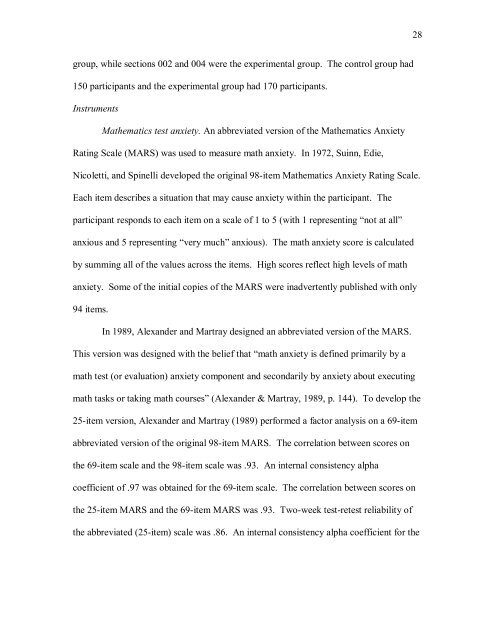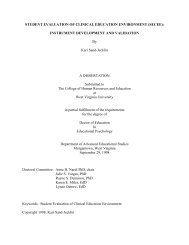The Effect of Background Music on the Mathematics Test Anxiety of ...
The Effect of Background Music on the Mathematics Test Anxiety of ...
The Effect of Background Music on the Mathematics Test Anxiety of ...
Create successful ePaper yourself
Turn your PDF publications into a flip-book with our unique Google optimized e-Paper software.
28<br />
group, while secti<strong>on</strong>s 002 and 004 were <strong>the</strong> experimental group. <str<strong>on</strong>g>The</str<strong>on</strong>g> c<strong>on</strong>trol group had<br />
150 participants and <strong>the</strong> experimental group had 170 participants.<br />
Instruments<br />
Ma<strong>the</strong>matics test anxiety. An abbreviated versi<strong>on</strong> <str<strong>on</strong>g>of</str<strong>on</strong>g> <strong>the</strong> Ma<strong>the</strong>matics <strong>Anxiety</strong><br />
Rating Scale (MARS) was used to measure math anxiety. In 1972, Suinn, Edie,<br />
Nicoletti, and Spinelli developed <strong>the</strong> original 98-item Ma<strong>the</strong>matics <strong>Anxiety</strong> Rating Scale.<br />
Each item describes a situati<strong>on</strong> that may cause anxiety within <strong>the</strong> participant. <str<strong>on</strong>g>The</str<strong>on</strong>g><br />
participant resp<strong>on</strong>ds to each item <strong>on</strong> a scale <str<strong>on</strong>g>of</str<strong>on</strong>g> 1 to 5 (with 1 representing “not at all”<br />
anxious and 5 representing “very much” anxious). <str<strong>on</strong>g>The</str<strong>on</strong>g> math anxiety score is calculated<br />
by summing all <str<strong>on</strong>g>of</str<strong>on</strong>g> <strong>the</strong> values across <strong>the</strong> items. High scores reflect high levels <str<strong>on</strong>g>of</str<strong>on</strong>g> math<br />
anxiety. Some <str<strong>on</strong>g>of</str<strong>on</strong>g> <strong>the</strong> initial copies <str<strong>on</strong>g>of</str<strong>on</strong>g> <strong>the</strong> MARS were inadvertently published with <strong>on</strong>ly<br />
94 items.<br />
In 1989, Alexander and Martray designed an abbreviated versi<strong>on</strong> <str<strong>on</strong>g>of</str<strong>on</strong>g> <strong>the</strong> MARS.<br />
This versi<strong>on</strong> was designed with <strong>the</strong> belief that “math anxiety is defined primarily by a<br />
math test (or evaluati<strong>on</strong>) anxiety comp<strong>on</strong>ent and sec<strong>on</strong>darily by anxiety about executing<br />
math tasks or taking math courses” (Alexander & Martray, 1989, p. 144). To develop <strong>the</strong><br />
25-item versi<strong>on</strong>, Alexander and Martray (1989) performed a factor analysis <strong>on</strong> a 69-item<br />
abbreviated versi<strong>on</strong> <str<strong>on</strong>g>of</str<strong>on</strong>g> <strong>the</strong> original 98-item MARS. <str<strong>on</strong>g>The</str<strong>on</strong>g> correlati<strong>on</strong> between scores <strong>on</strong><br />
<strong>the</strong> 69-item scale and <strong>the</strong> 98-item scale was .93. An internal c<strong>on</strong>sistency alpha<br />
coefficient <str<strong>on</strong>g>of</str<strong>on</strong>g> .97 was obtained for <strong>the</strong> 69-item scale. <str<strong>on</strong>g>The</str<strong>on</strong>g> correlati<strong>on</strong> between scores <strong>on</strong><br />
<strong>the</strong> 25-item MARS and <strong>the</strong> 69-item MARS was .93. Two-week test-retest reliability <str<strong>on</strong>g>of</str<strong>on</strong>g><br />
<strong>the</strong> abbreviated (25-item) scale was .86. An internal c<strong>on</strong>sistency alpha coefficient for <strong>the</strong>












